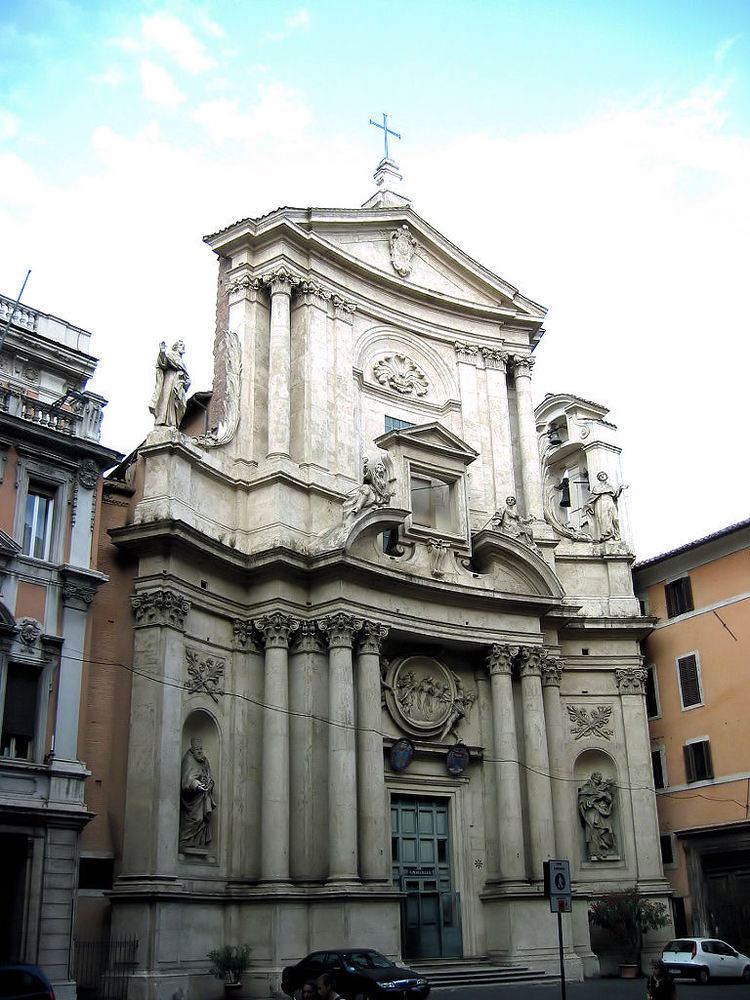Location Rome, Italy District Lazio Ecclesiastical or organizational status Titular church Leadership Giuseppe Betori Architect Carlo Fontana | Affiliation Roman Catholic Province Rome Phone +39 06 699301 Architectural type Church Burials Camillo Paolucci | |
 | ||
Address Piazza di S. Marcello, 5, 00187 Roma, Italy Similar San Giovanni a Porta Lati, Santa Maria in Via Lata, Santi Luca e Martina, Santi Quattro Coronati, Santi Apostoli - Rome | ||
Chiesa san marcello al corso a roma titolo cardinalizio di mons betori
Bold text
Contents
- Chiesa san marcello al corso a roma titolo cardinalizio di mons betori
- Roma il crocefisso miracoloso di san marcello al corso trasportato in san pietro con una grande
- History
- References
San Marcello al Corso, a church in Rome, Italy, is a titular church whose cardinal-protector normally holds the (intermediary) rank of cardinal-priest.
The church, dedicated to Pope Marcellus I, is located just inset from Via del Corso, in ancient times called via Lata, and which now connects Piazza Venezia to Piazza del Popolo. It stands diagonal from the church of Santa Maria in Via Lata and two doors from the Oratory of Santissimo Crocifisso.
Roma il crocefisso miracoloso di san marcello al corso trasportato in san pietro con una grande
History
While the tradition holds that the church was built over the prison of Pope Marcellus I (d. 309), it is known that the Titulus Marcelli was present no later than 418, when Pope Boniface I was elected there. The "Septiformis" litany, commanded by Pope Gregory I in 590, saw the men moving from San Marcello.
Pope Adrian I, in the 8th century, built a church on the same place, which is currently under the modern church.
The corpse of Cola di Rienzo was held in the church for three days after his execution in 1354. On 22 May 1519, a fire destroyed the church. The money collected for its rebuilding was used to bribe the landsknechts, who were pillaging the city during the Sack of Rome (1527). The original plan to rebuild the church was designed by Jacopo Sansovino, who fled the city during the Sack and never returned to finish it. The work was continued by Antonio da Sangallo the Younger, who rebuilt the church, but a Tiber flood damaged it again in 1530. It was only in 1592–1597 that the church was completed with a facade by Carlo Fontana, commissioned by Monsignor Marcantonio Cataldi Boncompagni. The exterior travertine statues were sculpted by Francesco Cavallini, and the stucco bas-relief over the entrance, with depicts San Filippo Benizio, was created by Antonio Raggi. Benizio had been a member of the Servite order.
Under the main altar, decorated with 12th century opus sectile, are the relics of several saints, which include those of Pope Marcellus as well as Digna and Emerita. The last chapel on the left is dedicated to St Philip Benizi. The late-Baroque decoration contains sculptures by Francesco Cavallini and reliefs by Ercole Ferrata and Antonio Raggi. The first chapel on the left has the double tomb of Cardinal Giovanni Michiel and his grandson Antonio Orso sculpted by Jacopo Sansovino.
Behind the facade is a Crucifixion (1613) by Giovanni Battista Ricci. The tomb of Cardinal Cennino was sculpted by Giovanni Francesco de'Rossi (la Vecchietta). Along the right, the first chapel of Marchese Maccarani holds an Annunciation by Lazzaro Baldi; in the second Martyrdom of Sts. Digna and Emerita (1727) of Pietro Barbieri (architecture by Francesco Ferrari); in the third Madonna with the Child, a fresco from the late 14th century, episodes of the life of the Virgin by Francesco Salviati, fresco and paintings of Giovan Battista Ricci; in the fourth chapel a Creation of Eve and the evangelists Mark and John, frescoes by Perino del Vaga, Matthew and Luke begun by Perino del Vaga and finished by Daniele da Volterra. Inside is a cyborium (1691) designed by Carlo Bizzaccheri; in the fifth chapel is a monument to the Cardinal Fabrizio Paolucci (1726) by Pietro Bracci with an altarpiece by Aureliano Milani and lateral paintings by Domenico Corvi; and a monument to cardinal Camillo Paolucci by Tommaso Righi (1776) and wall paintings by Aureliano Milani. On the left nave, in the fifth chapel, is a San Filippo Benizi (1725) by Pier Leone Ghezzi and Gagliardi; in the fourth Conversion of Saint Paul (1560) by Federico Zuccari and his brother Taddeo and, on the sides, of History of Saint Paul. Inside of the chapel has busts of Muzio, Roberto, Lelio Frangipane by Alessandro Algardi (1630–40). In the third chapel on the left is a Doloroso by Pietro Paolo Naldini, Sacrifice of Isaac and discovery of Moses by Domenico Corvi; in the first, Madonna and seven Saints by Agostino Masucci.
The church is administered and owned by the Servite Order since 1369.
